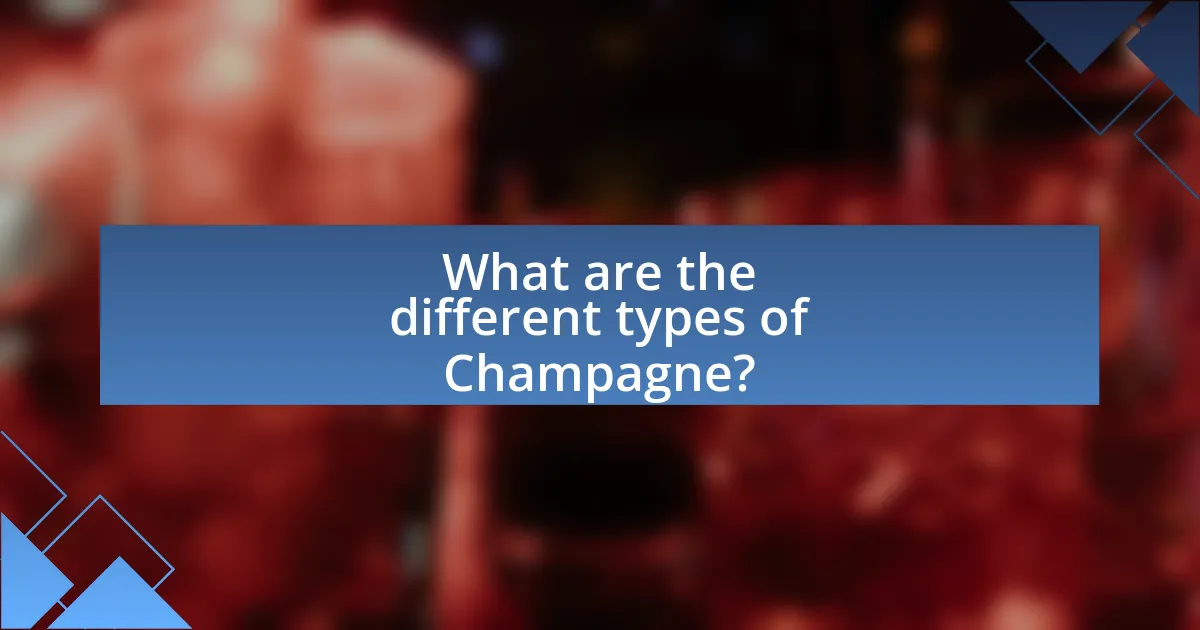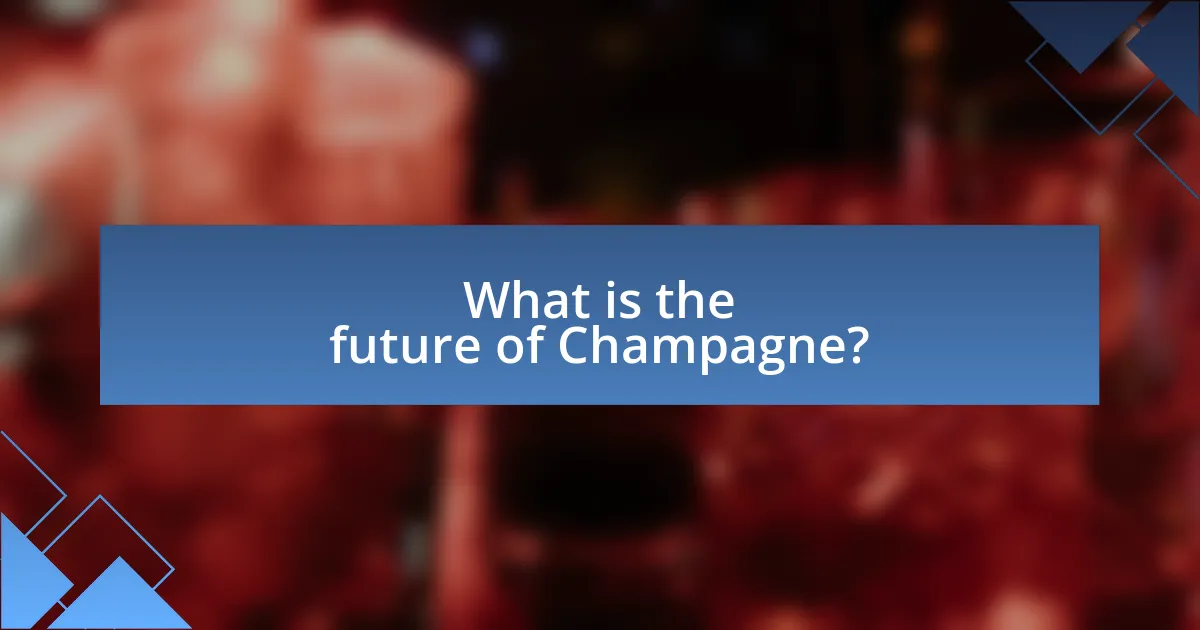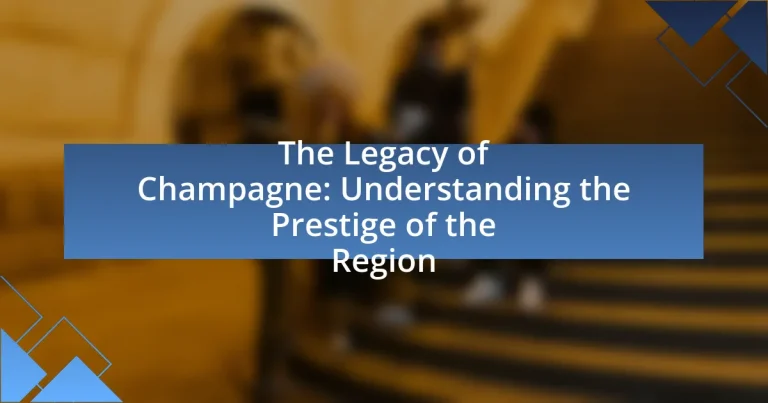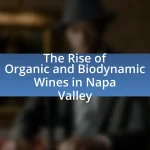The main entity of the article is Champagne, a prestigious sparkling wine originating from the Champagne region of France. The article explores the historical significance, cultural impact, and global recognition of Champagne as a symbol of luxury and celebration. It details the evolution of its production methods, the unique geographical factors influencing its quality, and the traditional practices that uphold its reputation. Additionally, the article addresses the challenges faced by the Champagne industry today, including climate change and competition, while highlighting the various types of Champagne and key producers in the region. Finally, it discusses the future of Champagne, focusing on sustainability and changing consumer preferences.

What is the Legacy of Champagne?
The legacy of Champagne is defined by its historical significance, cultural impact, and global recognition as a symbol of luxury and celebration. Originating from the Champagne region of France, this sparkling wine has been produced since the 17th century and is closely associated with royal courts and significant events, such as weddings and victories. The region’s unique terroir, characterized by its chalky soil and favorable climate, contributes to the distinct quality of Champagne, which is protected by strict regulations under the Appellation d’Origine Contrôlée (AOC) system. This legal framework ensures that only sparkling wines produced in this specific region using traditional methods can be labeled as Champagne, reinforcing its prestigious status worldwide.
How did Champagne become synonymous with luxury?
Champagne became synonymous with luxury primarily due to its historical association with royalty and celebration. In the 17th century, the region of Champagne in France began producing sparkling wine that was favored by French kings, notably Louis XIV, who popularized its consumption at royal events. This royal endorsement established Champagne as a drink of prestige. Additionally, the development of the méthode champenoise, a complex production process that enhances the wine’s quality and uniqueness, further elevated its status. By the 19th century, Champagne was marketed as a luxury product, with brands like Moët & Chandon and Veuve Clicquot leading the way in creating an image of exclusivity and sophistication. The combination of historical significance, meticulous production methods, and strategic marketing solidified Champagne’s reputation as a symbol of luxury.
What historical events contributed to Champagne’s prestige?
The historical events that contributed to Champagne’s prestige include its designation as a royal wine in the 17th century and the establishment of the Champagne Appellation d’Origine Contrôlée in the 20th century. The 17th century marked the beginning of Champagne’s association with French royalty, particularly when it became the preferred sparkling wine for the coronation of kings, enhancing its status. Additionally, the formal recognition of Champagne’s unique terroir and production methods through the Appellation d’Origine Contrôlée in 1927 solidified its reputation as a high-quality wine region, ensuring that only wines produced in the Champagne region could be labeled as such. These events collectively established Champagne as a symbol of luxury and celebration, contributing significantly to its enduring prestige.
How has the production process evolved over time?
The production process of Champagne has evolved significantly from its early methods to modern techniques. Initially, Champagne was produced using simple fermentation processes in the 17th century, often resulting in inconsistent quality and carbonation. The introduction of the méthode champenoise in the 19th century standardized production, allowing for controlled fermentation and the development of the signature bubbles that Champagne is known for today. This method involves secondary fermentation in the bottle, which was refined by figures such as Dom Pérignon, who is often credited with improving the quality of the wine. Additionally, advancements in technology, such as temperature control and the use of modern equipment, have further enhanced the precision and quality of Champagne production, leading to a more consistent and high-quality product that reflects the unique terroir of the Champagne region.
Why is the Champagne region significant?
The Champagne region is significant primarily because it is the exclusive origin of Champagne, the world-renowned sparkling wine. This region’s unique climate, chalky soil, and traditional production methods, including the méthode champenoise, contribute to the distinct characteristics of Champagne. The Champagne region has been recognized by UNESCO as a World Heritage site, highlighting its cultural and historical importance in viticulture. Additionally, the region’s strict regulations governing the production of Champagne ensure quality and authenticity, making it a symbol of luxury and celebration globally.
What geographical factors influence Champagne’s quality?
The geographical factors that influence Champagne’s quality include its chalky soil, climate, and topography. The chalky soil, rich in minerals, provides excellent drainage and reflects sunlight, which is crucial for grape ripening. The region’s cool climate, characterized by significant temperature variations between day and night, helps preserve acidity in the grapes, essential for producing high-quality sparkling wine. Additionally, the sloped topography allows for optimal sun exposure and air circulation, reducing the risk of frost and promoting even ripening. These factors collectively contribute to the unique characteristics and high standards of Champagne production.
How does the terroir affect the flavor profile of Champagne?
The terroir significantly influences the flavor profile of Champagne by imparting unique characteristics derived from the soil, climate, and topography of the Champagne region. The chalky soil, for instance, retains moisture and reflects sunlight, which enhances the ripening of grapes and contributes to the wine’s minerality and acidity. Additionally, the region’s cool climate allows for a slow maturation process, resulting in balanced acidity and complex flavors. Historical data shows that the specific terroir of Champagne, particularly the Montagne de Reims and Côte des Blancs areas, produces distinct flavor notes such as citrus, apple, and brioche, which are essential to the identity of Champagne.
What role do traditions play in Champagne production?
Traditions play a crucial role in Champagne production by ensuring the preservation of unique methods and quality standards that define the region’s sparkling wine. The Champagne production process is governed by strict regulations known as the “Champagne Appellation d’Origine Contrôlée,” which mandates traditional practices such as hand-harvesting grapes, secondary fermentation in the bottle, and specific blending techniques. These traditions not only maintain the distinct characteristics of Champagne but also contribute to its global reputation for excellence, as evidenced by the region’s designation as a UNESCO World Heritage site in 2015, highlighting its cultural significance and historical practices in winemaking.
What are the key traditional methods used in Champagne making?
The key traditional methods used in Champagne making include the méthode champenoise, which involves secondary fermentation in the bottle, and the use of specific grape varieties such as Chardonnay, Pinot Noir, and Pinot Meunier. The méthode champenoise, also known as the traditional method, is crucial as it creates the characteristic bubbles through in-bottle fermentation, where sugar and yeast are added to the base wine before sealing it. This process typically takes a minimum of 15 months for non-vintage Champagne and three years for vintage Champagne, allowing for the development of complex flavors. Additionally, the blending of different grape varieties and vintages is essential to achieve the desired style and consistency, reflecting the unique terroir of the Champagne region.
How do these traditions impact the perception of Champagne?
Traditions significantly enhance the perception of Champagne by associating it with luxury, celebration, and craftsmanship. The historical practices of meticulous grape selection, traditional fermentation methods, and the use of specific regional terroirs contribute to its esteemed reputation. For instance, the Champagne production process, which includes secondary fermentation in the bottle, is a hallmark of quality that distinguishes it from other sparkling wines. Additionally, cultural rituals surrounding Champagne, such as its role in weddings and New Year celebrations, reinforce its status as a symbol of prestige and special occasions. These elements collectively shape consumer perceptions, making Champagne synonymous with high-end experiences and celebratory moments.
How does the Champagne industry maintain its prestige?
The Champagne industry maintains its prestige through strict regulations, high-quality production standards, and a focus on terroir. The Champagne Appellation d’Origine Contrôlée (AOC) enforces rules regarding grape varieties, vineyard practices, and production methods, ensuring that only wines produced in the designated Champagne region can be labeled as Champagne. This regulatory framework, established in the early 20th century, preserves the unique characteristics of the region’s wines. Additionally, the emphasis on traditional methods, such as secondary fermentation in the bottle, contributes to the distinct quality and flavor profile associated with Champagne. The industry also invests in marketing and branding, reinforcing its image as a luxury product through associations with celebrations and high-profile events.
What challenges does the Champagne region face today?
The Champagne region faces several significant challenges today, including climate change, economic pressures, and competition from other sparkling wine producers. Climate change has led to unpredictable weather patterns, affecting grape quality and harvest yields; for instance, rising temperatures can cause grapes to ripen too quickly, impacting the balance of acidity and sugar. Economic pressures arise from fluctuating market demands and the need for producers to adapt to changing consumer preferences, which can strain traditional practices. Additionally, competition from regions like Prosecco in Italy and Cava in Spain has intensified, as these alternatives often offer lower prices and appeal to a broader audience. These factors collectively threaten the long-standing prestige and economic viability of the Champagne region.

What are the different types of Champagne?
The different types of Champagne include Non-Vintage, Vintage, Blanc de Blancs, Blanc de Noirs, and Rosé. Non-Vintage Champagne is a blend of wines from multiple years, ensuring consistency in flavor. Vintage Champagne is made from grapes harvested in a single year, reflecting the characteristics of that specific vintage. Blanc de Blancs is produced exclusively from white grapes, primarily Chardonnay, offering a lighter taste. Blanc de Noirs is made from black grapes, typically Pinot Noir and Pinot Meunier, resulting in a fuller-bodied flavor. Rosé Champagne is created by blending red and white wines or through limited skin contact with red grapes, providing a pink hue and unique taste profile. Each type showcases the diverse expressions of Champagne, contributing to its prestige and legacy.
How do the various styles of Champagne differ?
The various styles of Champagne differ primarily in their sweetness levels, grape composition, and production methods. For instance, Champagne can be categorized into styles such as Non-Vintage (NV), Vintage, Blanc de Blancs, and Blanc de Noirs, each offering distinct flavor profiles and characteristics. Non-Vintage Champagne blends wines from multiple years, providing consistency, while Vintage Champagne is made from grapes harvested in a single year, showcasing the unique qualities of that specific harvest. Blanc de Blancs is produced exclusively from Chardonnay grapes, resulting in a lighter, more delicate flavor, whereas Blanc de Noirs is made from Pinot Noir and/or Pinot Meunier, offering a fuller-bodied experience. These differences are further influenced by the terroir of the Champagne region, which includes soil composition, climate, and vineyard practices, all contributing to the complexity and prestige associated with Champagne.
What distinguishes non-vintage from vintage Champagne?
Non-vintage Champagne is made from a blend of wines from multiple years, while vintage Champagne is produced from grapes harvested in a single year. Non-vintage Champagne aims for consistency in flavor and style, reflecting the house’s signature profile, whereas vintage Champagne showcases the unique characteristics of a specific year’s harvest, often resulting in more complex and nuanced flavors. Vintage Champagne is typically only produced in exceptional years, which adds to its prestige and rarity, as evidenced by the fact that only about 5-10% of Champagne produced is vintage.
How do rosé and blanc de blancs Champagne compare?
Rosé Champagne and Blanc de Blancs Champagne differ primarily in their grape composition and flavor profiles. Rosé Champagne is made from a blend of red and white grapes, typically including Pinot Noir and Pinot Meunier, which gives it a pink hue and a fruitier, berry-like flavor. In contrast, Blanc de Blancs Champagne is exclusively produced from Chardonnay grapes, resulting in a lighter, crisper taste with floral and citrus notes. This distinction in grape variety directly influences the overall taste, aroma, and mouthfeel of each type, with rosé often being richer and more robust, while Blanc de Blancs is known for its elegance and finesse.
What are the key producers in the Champagne region?
The key producers in the Champagne region include Moët & Chandon, Veuve Clicquot, Dom Pérignon, and Krug. These producers are renowned for their high-quality sparkling wines and have established a significant presence in the global market. Moët & Chandon, for instance, is one of the largest producers and is known for its flagship Brut Impérial. Veuve Clicquot is famous for its distinctive yellow label and innovative winemaking techniques. Dom Pérignon, a prestigious vintage champagne, is produced by Moët & Chandon and is celebrated for its luxury status. Krug is recognized for its artisanal approach and emphasis on terroir, producing some of the most sought-after champagnes.
Which houses are considered the most prestigious?
The most prestigious houses in Champagne include Moët & Chandon, Dom Pérignon, Veuve Clicquot, and Krug. These houses are renowned for their exceptional quality, historical significance, and influence in the global champagne market. For instance, Moët & Chandon, founded in 1743, is one of the largest and most recognized champagne producers worldwide, while Dom Pérignon, named after the Benedictine monk credited with developing champagne production methods, is synonymous with luxury and exclusivity. Veuve Clicquot, established in 1772, is famous for its innovative practices and iconic yellow label, and Krug is celebrated for its artisanal approach and commitment to quality, producing only prestige cuvées.
How do smaller producers contribute to the Champagne landscape?
Smaller producers significantly enhance the Champagne landscape by promoting diversity and innovation within the region. These producers, often referred to as “grower Champagne” houses, cultivate their own grapes and emphasize unique terroirs, resulting in a wide array of flavor profiles and styles. According to the Champagne Bureau, approximately 90% of Champagne producers are classified as small, with many producing less than 5,000 bottles annually. This concentration of smaller houses fosters a competitive environment that encourages experimentation with traditional methods and grape varieties, thereby enriching the overall quality and reputation of Champagne.

What is the future of Champagne?
The future of Champagne is likely to involve a focus on sustainability and innovation in production methods. As climate change impacts grape growing conditions, producers are adapting by implementing environmentally friendly practices and exploring new grape varieties that can withstand changing climates. For instance, the Champagne region has seen a rise in organic and biodynamic viticulture, with over 10% of vineyards certified organic as of 2023. Additionally, advancements in technology, such as precision viticulture, are enhancing the quality and efficiency of Champagne production. These trends indicate that the Champagne industry is evolving to maintain its prestige while addressing environmental challenges.
How is climate change affecting Champagne production?
Climate change is significantly impacting Champagne production by altering temperature and precipitation patterns, which affects grape growing conditions. Rising temperatures lead to earlier grape ripening, resulting in higher sugar levels and lower acidity in the grapes, which can compromise the quality and balance of the final product. Additionally, increased frequency of extreme weather events, such as frost and heavy rainfall, poses risks to vineyard health and yields. According to a study by the Champagne Committee, the region has experienced a temperature increase of approximately 1.5 degrees Celsius since the 1950s, which has already begun to shift the traditional harvest dates and grape varieties used in production.
What adaptations are producers making to ensure quality?
Producers in the Champagne region are implementing several adaptations to ensure quality, including the adoption of precision viticulture techniques and enhanced fermentation processes. Precision viticulture utilizes technology such as drones and soil sensors to monitor vineyard conditions, allowing for tailored interventions that optimize grape health and ripeness. Additionally, producers are increasingly employing temperature-controlled fermentation to maintain the integrity of flavors and aromas during the winemaking process. These adaptations are supported by research indicating that such practices can significantly improve the consistency and quality of Champagne, as evidenced by studies from the Champagne Bureau which highlight the correlation between vineyard management and wine quality.
How might consumer preferences shape the future of Champagne?
Consumer preferences will significantly shape the future of Champagne by driving trends towards sustainability, lower-alcohol options, and diverse flavor profiles. As consumers increasingly prioritize environmental responsibility, Champagne producers are likely to adopt sustainable practices, such as organic farming and eco-friendly packaging, to meet this demand. Additionally, the growing interest in health-conscious choices may lead to a rise in the production of lower-alcohol Champagne, appealing to a demographic that seeks moderation without sacrificing quality. Furthermore, the exploration of unique and innovative flavor profiles, influenced by global wine trends, will cater to adventurous consumers looking for new experiences. This shift is supported by market research indicating that younger consumers are more inclined to experiment with different styles and brands, thus influencing producers to adapt their offerings accordingly.
What tips can enhance the Champagne experience?
To enhance the Champagne experience, serve Champagne at the optimal temperature of 45-50°F (7-10°C) to fully appreciate its flavors and aromas. This temperature allows the delicate notes of the wine to emerge, providing a more enjoyable tasting experience. Additionally, using proper glassware, such as flutes or tulip-shaped glasses, helps concentrate the aromas and maintain the bubbles longer, enhancing the overall sensory experience. Pairing Champagne with complementary foods, like oysters or soft cheeses, can also elevate the tasting experience, as the acidity and effervescence of Champagne balance rich flavors.


